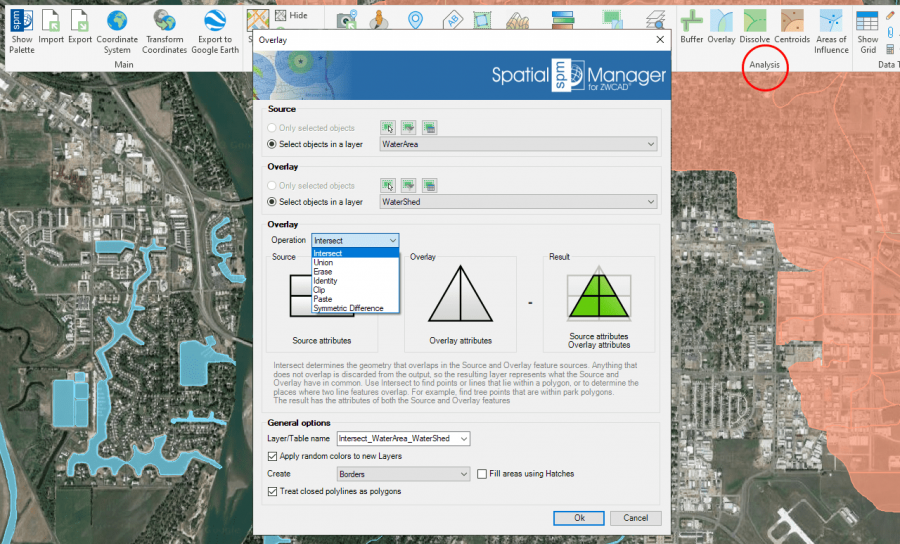Spatial Manager™ for ZWCAD - FAQs: GIS Analysis ("Professional" edition only)
Notes:
- Some components in the images on this page (providers, names, windows look, etc.) may be slightly different from those that will appear on your computer
- Some application functions need to access the Internet from the application itself. If you experiment problems in any process, ask your network administrator if there is a Proxy server installed on your network. You can configure the Proxy settings through the application options
- Some geographic data providers (Geocode, image Maps, etc.) may need a user account, which you can configure in the Service Provider API Keys settings through the application options
Introduction
- Objective of this section
- To learn how to use advanced GIS analysis tools in your drawings and maps
- Topics in this section
- Create Buffers from point, linear or polygonal borders entities
- Process spatial Overlays which will create new drawing entities based on the operation results
- Dissolve polyonal entities in order to create surrounds of adjacent entities
- Create Centroids from selected polygons or add Centroids data to the polygons that contain them
- Calculate and draw Areas of Influence from selected point entities
GIS Analysis tools
Spatial Manager™ for ZWCAD includes a set of advanced tools designed for geometric and spatial analysis of geographic entities and their geometric relationships, resulting in new entities generated from the resolution of such analysis

Performing GIS Analysis in the drawing
About entities selection
Some of the analysis tools described below allow entity selections before or during their execution. Even some of them (such as SPMOVERLAY or SPMCENTROID) allow you to select two groups of entities to operate between them. For all of these commands, the following notes and instructions apply:
- Select all objects: All entities in the drawing will be processed
- Only selected objects: Only a selection of entities will be processed. You can select the entities before executing the commands or by using the Selecting buttons in their corredponding windows
- Manual selection
- Select by Query: Select entities according to the result of a simplex or compound data query (See "Selecting by Query")
- Select by Table: Select entities which have been previously attached to a specific data table (See "Selecting by Table")
- Note: As you can select the entities previously to execute the commands, in addition to the use of the above included selection options or in combination with them, you can make use of some other Advanced selection application tools, select entities in the Data Grid or any other selection method available in ZWCAD (Quick Select, etc.). Also note that, as most of the advanced application or ZWCAD selection commands will let you apply the selection to the current selection, the number of possible combinations to select what you are interested in is almost unlimited
- Select objects in a layer: Only the entities included in an ZWCAD Layer will be processed. You can select the layer using the drop-down list in this window
Note: The selection of entities in ZWCAD may be a few slower when the "SpatialManager" palette is open, depending on the data of the entities
Buffer
The command 'SPMBUFFER' in Spatial Manager™ for ZWCAD allows you to generate Buffered polygons around point entities, linear entities or polygon boundaries. Buffer distance can be constant or taken from the value of a table field for each entities, it is possible to merge the generated entities in their common areas and different styles of joins and endings can be chosen
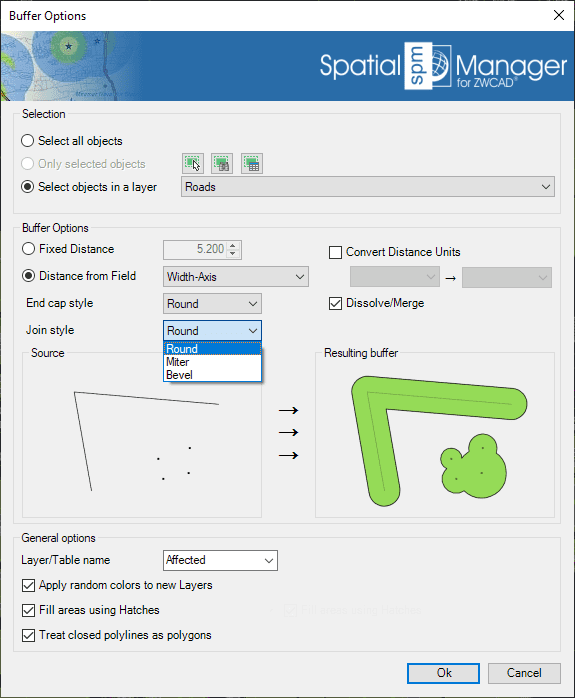
- Entities selection: See the paragraph "About entities selection" above
- Buffer options: You can select the Buffer distance (fixed value or field-based value), the distance units (read below), the Join and End cap styles and if you want to Dissolve/Merge the generated Buffered polygons
- About Units conversion: If a coordinate system with a defined unit of measurement is assigned to the drawing, the user can select another unit from the drop-down list to define the Buffer distance entered and the application will perform the conversion between it and the one defined by the coordinate system. If the drawing does not have a coordinate system assigned to it, or the coordinate system does not have defined units, the user can select from the drop-down lists the unit in which the entered Buffer distance is defined and the drawing units; the application will perform the conversion between the two
- Table/Layer name: This setting defines the target Layer and data table name for the Buffers. You can select an existing Layer in the drawing or you can write the name to create a new Layer. Buffer entities will adopt the same data as the entities that generate them, unless the "Dissolve/Merge" option has been checked, in which case this would not make sense and the combined Buffer entities are not attached to any data table
- Apply random colors to new Layers
- Fill areas using Hatches
- Treat closed polylines as polygons: When checked (default value), all closed Polylines in the drawing will be considered as Polygons and not as linear entities. Most of the time the closed polylines represent polygonal elements
Overlay
The command 'SPMOVERLAY' in 'Spatial Manager™ for ZWCAD' allows you to create new entities based on geometric and data operations between two existing entitiy groups
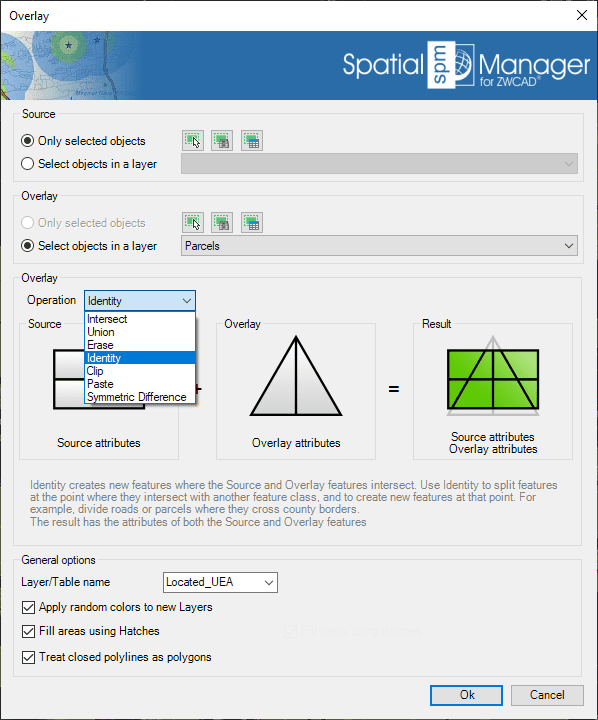
This function allows you to generate new entities in the drawing by performing "geometric operations" between two groups of existing entities: "Source" (Group 1) and "Overlay" (Group 2). For example, according to the chosen parameters in this image, for all selected Source entities (Roads, etc.) that are located within any Parcel, the Overlay Identity function will create new entities which will are equal to the Source entities "broken" in the Parcel limits
- Entities selection: See the paragraph "About entities selection" above (Group 1 and Group 2)
- Overlay parameters and options
- Operation
- Intersect: Determines the geometries that overlap in the Source and Overlay entity groups. Anything that does not overlap is discarded from the output, so the resulting entities represent what the Source and Overlay have in common. Use Intersect in order to find points or lines that lie within a polygon, or to determine the places where two linear entities overlap. For example, find tree point entities that are within park polygons. The resulting data table will include the data of both the Source and Overlay entities
- Union: Determines the geometries that exist in either the Source and Overlay entities. Where the geometries intersect, additional entities are created. The resulting entities are the sum of the two comparison entity groups. Use Union in order to combine two group of related polygon entities. For example, create new entities that combine the business district and the theater district when the entities overlap. The resulting data table will include the data of both the Source and Overlay entities
- Erase: Determines the geometries from the Source entities that do not intersect with the Overlay entities. Use Erase in order to subtract sections for a group of entities. For example, find all roads that lie outside the enterprise district, or all hospitals that are outside a flod zone. The resulting data table will include the data of Source entities only
- Identity: Creates new entities where the Source and Overlay entities intersect. Use Identity in order to split entities at the point where they intersect with another entities group, and to create new entities at that point. For example, divide roads or parcels where they cross city borders. The resulting data table will include the data of both the Source and Overlay entities
- Clip: Like Intersect, Clip creates entities from the areas of the Source that overlap with the Overlay. Use Clip in order to find entities that lie within a geometric area. For example, find hydrants within a development, or road segments within a particular neighborhood. The resulting data table will include the data of Source entities only
- Paste: Creates new entities by pasting the Overlay entities onto the Source entities. All Overlay entities become new entities in the operation result. In addition, the areas of the Source that do not fall within the Overlay entities become also new entities in the operation result. Use Paste in order to combine two overlaping groups of entities. For example, add the data of city districts to the developments that overlap. The resulting data table will include the data of both the Source and Overlay entities
- Symmetric Difference: Determines the areas in the Source and Overlay that do not overlap. Overlapping areas of the entities are discarded in the output. The non-overlapping areas become new entities. Use Symmetric Difference in order to find areas that are mutually exclusive in two group of entities. For example, find new housing developments that are outside school districts. The resulting data table will include the data of both the Source and Overlay entities
- General options
- Table/Layer name: This setting defines the target Layer and data table name for the new created entities. You can select an existing Layer in the drawing or you can write the name to create a new Layer. The data of the new entities will be those of the entities selected in Group 1. Whenever possible (depending on the type of Overlay operation), data from Group 2 will be merged in the same table. For example, if Buildings and Parcels are Overlapped by Intersection, the new entities will be geometrically equal to the buildings that are located entirely or partially within any parcel, and the data table will include the data of the buildings and parcels in a combined table
- Apply random colors to new Layers
- Fill areas using Hatches
- Treat closed polylines as polygons (Both Source and Overlay sets): When checked (default value), all closed Polylines in the drawing will be considered as Polygons and not as linear entities. Most of the time the closed polylines represent polygonal elements
- Table/Layer name: This setting defines the target Layer and data table name for the new created entities. You can select an existing Layer in the drawing or you can write the name to create a new Layer. The data of the new entities will be those of the entities selected in Group 1. Whenever possible (depending on the type of Overlay operation), data from Group 2 will be merged in the same table. For example, if Buildings and Parcels are Overlapped by Intersection, the new entities will be geometrically equal to the buildings that are located entirely or partially within any parcel, and the data table will include the data of the buildings and parcels in a combined table
- Operation
Dissolve
The command 'SPMDISSOLVE' in Spatial Manager™ for ZWCAD allows you to generate new Polygons based on the grouping of other adjacent polygons with some common data
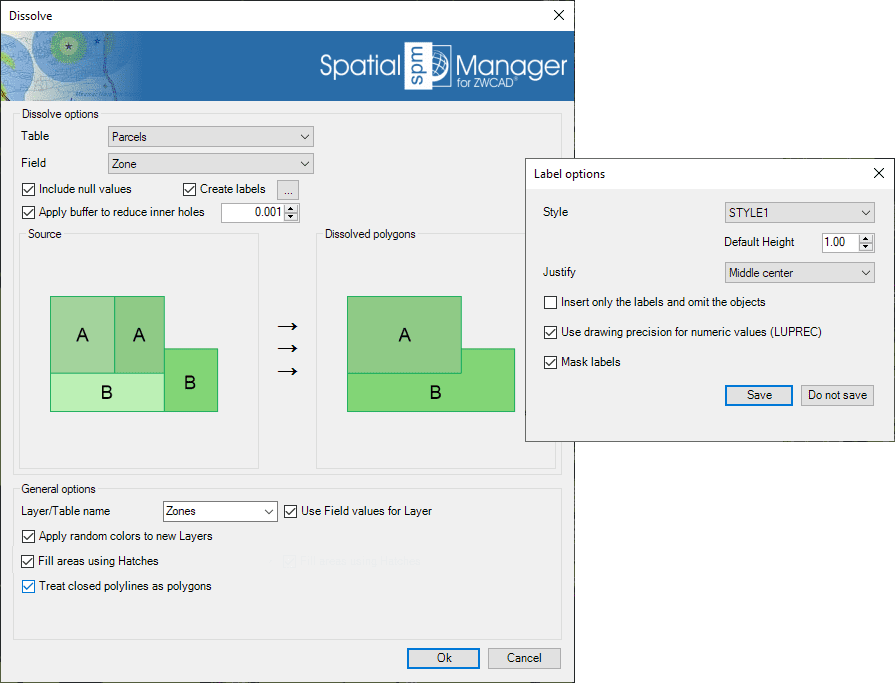
- Dissolve options: You can select the common Table/Field data for dissolving the polygons (even including null data). To reduce possible precision errors in the geometry, you can check the option to generate a temporary small buffer around the polygon boundaries in order to avoid as much as possible the generation of inner holes during the operation. Check the option "Create labels" if you want to Label the common data for every new polygon
- Label options. You can define the Style, Height and Justification of the Label Text entities here. You can configure if you want to insert the new Polygons geometry and its Labels or the Labels only. Be careful: if you check this box you will only get the Labels (Text entities) but not the dissolved polygons. As added parameters, you can set the option to use or not LUPREC for decimal places (see Notes below) and Mask labels which will generate masks (Wipeout entities, grouped with the Labels) and they will "trim" the entities located behind the Labels in order to improve its reading
- Notes:
- You can choose that the value of the LUPREC variable (Length precision) be used or not for the number of decimal places when labeling entities using a numerical field (Please, take a look to LUPREC and UNITS in the ZWCAD Help)
- Label Masks are available for ZWCAD 2020 SP2 Special Package (2020.05.15 - 56123) and upper versions
- Notes:
- Label options. You can define the Style, Height and Justification of the Label Text entities here. You can configure if you want to insert the new Polygons geometry and its Labels or the Labels only. Be careful: if you check this box you will only get the Labels (Text entities) but not the dissolved polygons. As added parameters, you can set the option to use or not LUPREC for decimal places (see Notes below) and Mask labels which will generate masks (Wipeout entities, grouped with the Labels) and they will "trim" the entities located behind the Labels in order to improve its reading
- Table/Layer name: This setting defines the target Layer and data table name for the new dissolved Polygons. You can select an existing Layer in the drawing or you can write the name to create a new Layer. Dissolved polygons will include the common dissolve data (1 field) as the polygons to dissolve
- As you can see in the next setting, the Layer name can be variable for each new polygon but the Table name for the attached data will be unique for all the created polygons
- Use Field values for Layer: Here you can select that the Field used to merge define its value as the name of the Layer for the new polygons. If this value is null for any polygon, or the setting is left blank, the polygon will be drawn in the Layer selected in the previous setting
- Note that this setting is only for the name of the target Layer but not for the Table name
- Apply random colors to new Layers
- Fill areas using Hatches
- Treat closed polylines as polygons: When checked (default value), all closed Polylines in the drawing will be considered as Polygons and not as linear entities. Most of the time the closed polylines represent polygonal elements
Note: Since this operation can only be performed on polygonal objects, the application will alert the user either if there are non-polygonal objects attached to the selected table (warning) or if there are not enough polygons to process it (cancellation)
Centroids
The command 'SPMCENTROID' in Spatial Manager™ for ZWCAD includes two functionalities. The first one allows you to generate Centroids (Point entities) for the selected polygons (The polygons data, if any, will be attached also to the Centroid entities). The second one allows you to capture the selected Centroids data in order to add it to a copy of the selected Polygons that contain them
Create centroids
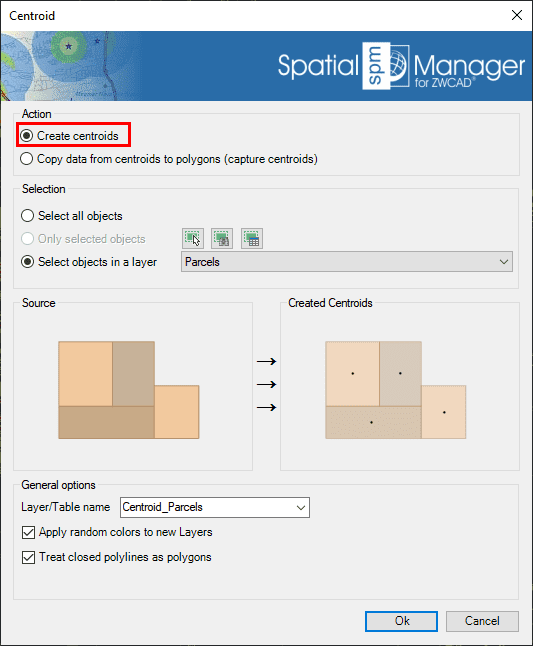
- Entities selection: See the paragraph "About entities selection" above
- Table/Layer name: This setting defines the target Layer and data table name for the Centroids. You can select an existing Layer in the drawing or you can write the name to create a new Layer. Centroids entities will adopt the same data as the corresponding polygons
- Apply random colors to new Layers
- Treat closed polylines as polygons: When checked (default value), all closed Polylines in the drawing will be considered as Polygons and not as linear entities. Most of the time the closed polylines represent polygonal elements
Copy data from centroids to polygons (capture centroids)
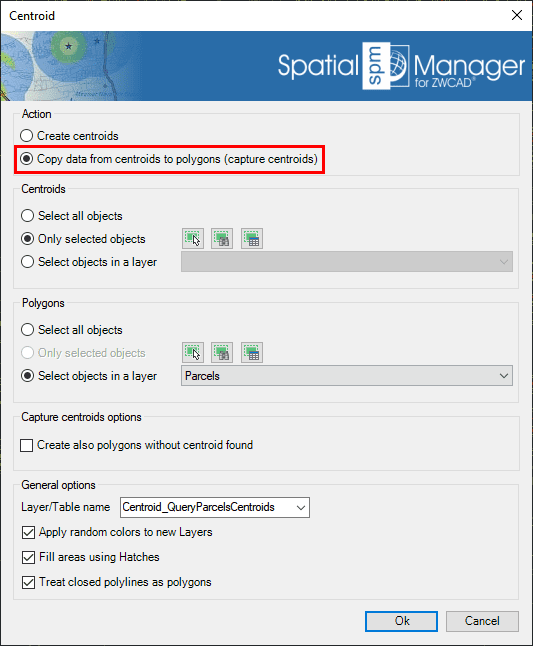
- Centroids selection: Any point entity. See the paragraph "About entities selection" above
- Polygons selection: Any polygonal entity. See the paragraph "About entities selection" above
- Capture centroids options
- Create also polygons without centroid found: As a copy of the selected polygons that contain any Centroid will be created, you can also choose to duplicate even polygons without Centroid found
- Table/Layer name: This setting defines the target Layer and data table name for the created polygons. You can select an existing Layer in the drawing or you can write the name to create a new Layer
- Apply random colors to new Layers
- Fill areas using Hatches
- Treat closed polylines as polygons: When checked (default value), all closed Polylines in the drawing will be considered as Polygons and not as linear entities. Most of the time the closed polylines represent polygonal elements
Areas of Influence
The command 'SPMINFLUENCEAREAS' in Spatial Manager™ for ZWCAD allows you to generate Polygons defined by the set of points closest to each point of a selection of Points in the drawing (Voronoi diagram). Each Polygon generated will adopt the same data (if any) as the corresponding Point. For example, would serve to determine which nearby areas are covered by each pharmacy in a municipality, and similar scenarios
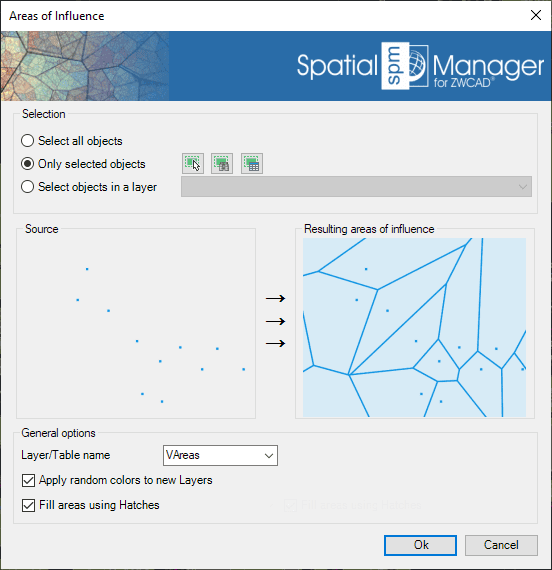
- Entities selection: See the paragraph "About entities selection" above
- Table/Layer name: This setting defines the target Layer and data table name for the new Polygons. You can select an existing Layer in the drawing or you can write the name to create a new Layer. Areas of Influence entities will adopt the same data as the corresponding Points
- Apply random colors to new Layers
- Fill areas using Hatches
Related links
- Blog posts
